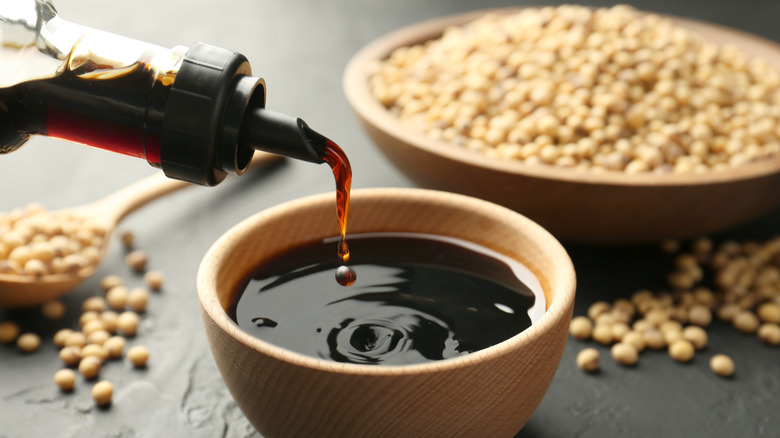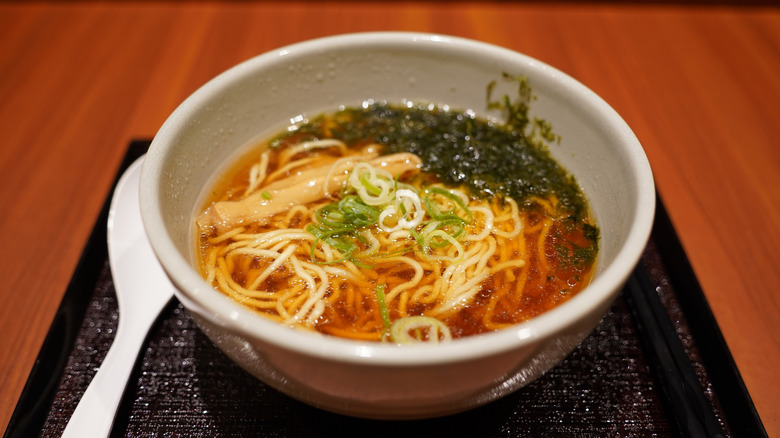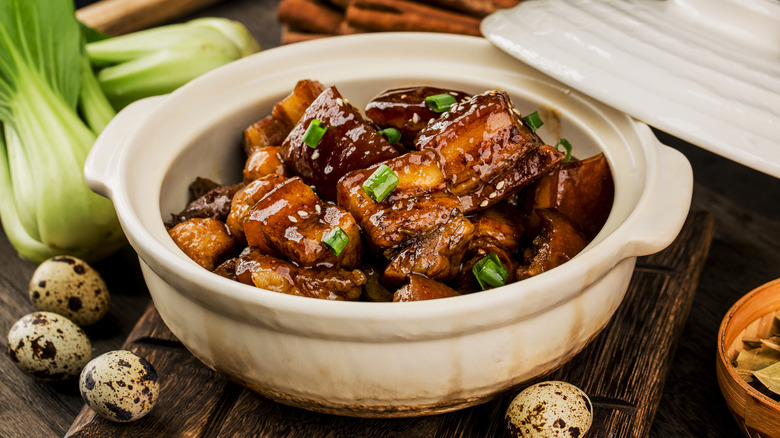What's The Difference Between Light And Dark Soy Sauce?
The world of soy sauce can be a confusing one. As ingredients from around the world become more available throughout the United States, the number of soy sauce variants you find on the shelves has also increased. While a few years ago a "lite" soy sauce might've just meant one that contained less sodium, now you may also see "light" soy sauce that also has a different look and taste.
Though there are many different varieties of soy sauce that hail from different cultures across Asia, the primary focus of this article is Chinese cuisine and the differences between light and dark soy sauce. Light soy sauce, with its salty and slightly sour flavor, thinner texture, and lighter color, is the norm in Chinese kitchens. Dark soy sauce, on the other hand, is deeper in color, more viscous in texture, and a touch sweeter in taste.
To truly understand the differences in these sauces, we'll need to dive pretty deeply into the topic. Soy sauce is thought to have first been developed around 2,000 years ago in China. It is made from a mixture of soybeans and grains such as wheat that are cooked before being fermented through inoculation with koji mold. Later, brine is introduced to add a salty flavor and prevent spoilage during the rest of the fermentation and aging process. Once properly aged, it is pressed, pasteurized, and bottled before heading to market.
Light soy sauce is the norm for Chinese cooking
The concept of light soy sauce might be a relatively new one for many Western home cooks, but it's the go-to condiment for Chinese cooking. The flavor of light soy sauce is more pungent, with a saltier bite and mild acidity. But when it comes to Chinese cooking, this is the norm. If you are cooking a Chinese recipe and the variety of soy sauce is not made clear (such as if the recipe simply reads "soy sauce"), this is the bottle to reach for. But it's important to note that it is also not the same as the standard soy sauce you use with Japanese food.
In Japan, the standard soy sauce is koikuchi shoyu, which is also referred to as Japanese dark soy sauce. This is the prototypical soy sauce that most Americans probably think of, like what you get in a bottle of Kikkoman Soy Sauce from the grocery store. Koikuchi shoyu falls somewhere between light and dark Chinese soy sauces in terms of color and flavor, but can generally be used like light Chinese soy sauce.
For proper Chinese cooking, you'll want to pick up a bottle like Light Soy Sauce from Pearl River Bridge. You can compare its taste with Japanese shoyu koikuchi like Kikkoman to see how it differs from what you might think of as "standard" soy sauce. This Chinese light soy sauce works perfectly in recipes like honey garlic crispy beef, as well as perfect fried rice.
Dark Chinese soy sauce adds color and sweetness to dishes
As mentioned, Chinese dark soy sauce tends to be (surprise) darker than light soy sauce, and has a correspondingly deep flavor. This difference is achieved through a longer fermentation period and the addition of molasses or palm sugar. These additions are responsible not only for sweetening the sauce, but also thickening and darkening it, which make it ideal for creating rich stews and luscious glazes. While dark soy sauce actually contains higher levels of sodium, this saltiness is balanced by its increased sweetness and depth of flavor.
In Chinese cuisine, dark soy sauce is typically reserved for dishes such as stews, braises, barbecue, and other dishes that seek to make use of the sauce's dark color, subtle sweetness, and complex flavor. You can pick up a bottle of Pearl River Bridge Dark Soy Sauce and give it a try for dishes like char siu and Chinese-style braised pork. You can also add a bit of dark soy sauce to your gravy for a pop of color and a punch of umami. If you want to add more depth of flavor to your Chinese dishes, use dark soy sauce. If you're looking to complement the flavor without altering it greatly, try light soy sauce.


